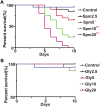Effects of spinetoram and glyphosate on physiological biomarkers and gut microbes in Bombus terrestris
- PMID: 36699673
- PMCID: PMC9868390
- DOI: 10.3389/fphys.2022.1054742
Effects of spinetoram and glyphosate on physiological biomarkers and gut microbes in Bombus terrestris
Abstract
The sublethal effects of pesticide poisoning will have significant negative impacts on the foraging and learning of bees and bumblebees, so it has received widespread attention. However, little is known about the physiological effects of sublethal spinetoram and glyphosate exposure on bumblebees. We continuously exposed Bombus terrestris to sublethal (2.5 mg/L) spinetoram or glyphosate under controlled conditions for 10 days. The superoxide dismutase, glutathione-S-transferase, carboxylesterase, prophenoloxidase, α-amylase and protease activities, and changes in gut microbes were measured to understand the effects of sublethal pesticide exposure on the physiology and gut microbes of bumblebees. Sublethal pesticide exposure to significantly increased superoxide dismutase activity and significantly decreased gut α-amylase activity in bumblebees but had no significant effect on glutathione-S-transferase, carboxylesterase or gut protease activities. In addition, glyphosate increased the activity of prophenoloxidase. Interestingly, we observed that neither of the two pesticides had a significant effect on dominant gut bacteria, but glyphosate significantly altered the structure of the dominant gut fungal community, and reduced the relative abundance of Zygosaccharomyces associated with fat accumulation. These results suggest that sublethal spinetoram and glyphosate do not significantly affect the detoxification system of bumblebees, but may affect bumblebee health by inhibiting energy acquisition. Our results provide information on the sublethal effects of exposure to low concentrations of glyphosate and spinetoram on bumblebees in terms of physiology and gut microbes.
Keywords: bumblebees; glyphosate (GLY); gut microbes; physiological biomarkers; spinetoram; sublethal effects.
Copyright © 2023 Tang, Li, Wang, Li, Li, Cao, Huang, Li, Zhang, Wang, Guo and Li.
Conflict of interest statement
The authors declare that the research was conducted in the absence of any commercial or financial relationships that could be construed as a potential conflict of interest.
Figures




Similar articles
-
Lethal and sublethal side-effect assessment supports a more benign profile of spinetoram compared with spinosad in the bumblebee Bombus terrestris.Pest Manag Sci. 2011 May;67(5):541-7. doi: 10.1002/ps.2093. Epub 2011 Jan 11. Pest Manag Sci. 2011. PMID: 21472971
-
Glyphosate and spinetoram alter viral communities with different effects on antibiotic resistance genes in the bumblebee gut.J Environ Manage. 2025 Feb;374:124079. doi: 10.1016/j.jenvman.2025.124079. Epub 2025 Jan 10. J Environ Manage. 2025. PMID: 39798326
-
Glyphosate and a glyphosate-based herbicide affect bumblebee gut microbiota.FEMS Microbiol Ecol. 2023 Jun 16;99(7):fiad065. doi: 10.1093/femsec/fiad065. FEMS Microbiol Ecol. 2023. PMID: 37316439 Free PMC article.
-
Field-realistic acute exposure to glyphosate-based herbicide impairs fine-color discrimination in bumblebees.Sci Total Environ. 2023 Jan 20;857(Pt 1):159298. doi: 10.1016/j.scitotenv.2022.159298. Epub 2022 Oct 7. Sci Total Environ. 2023. PMID: 36216073
-
Bumblebees with the socially transmitted microbiome: A novel model organism for gut microbiota research.Insect Sci. 2022 Aug;29(4):958-976. doi: 10.1111/1744-7917.13040. Epub 2022 May 14. Insect Sci. 2022. PMID: 35567381 Review.
Cited by
-
Bees just wanna have fungi: a review of bee associations with nonpathogenic fungi.FEMS Microbiol Ecol. 2023 Jul 21;99(8):fiad077. doi: 10.1093/femsec/fiad077. FEMS Microbiol Ecol. 2023. PMID: 37422442 Free PMC article. Review.
-
Effects of field releases of Neoseiulus barkeri on Megalurothrips usitatus abundance and arthropod diversity.Sci Rep. 2024 Jun 20;14(1):14247. doi: 10.1038/s41598-024-64740-y. Sci Rep. 2024. PMID: 38902417 Free PMC article.
-
Gut microbiota-driven regulation of queen bee ovarian metabolism.Microbiol Spectr. 2023 Sep 26;11(5):e0214523. doi: 10.1128/spectrum.02145-23. Online ahead of print. Microbiol Spectr. 2023. PMID: 37750696 Free PMC article.
-
Glyphosate-Based Herbicides and Their Potential Impact on the Microbiota of Social Bees.Toxics. 2025 Jun 29;13(7):551. doi: 10.3390/toxics13070551. Toxics. 2025. PMID: 40710996 Free PMC article. Review.
-
No impacts of glyphosate or Crithidia bombi, or their combination, on the bumblebee microbiome.Sci Rep. 2023 Jun 2;13(1):8949. doi: 10.1038/s41598-023-35304-3. Sci Rep. 2023. PMID: 37268667 Free PMC article.
References
-
- Abdelsalam S., Alzahrani A. M., Elmenshawy O. M., Abdel-Moneim A. M. (2020). Antioxidant status and ultrastructural defects in the ovaries of red palm weevils (Rhynchophorus ferrugineus) intoxicated with spinosad. Entomol. Res. 50, 309–316. 10.1111/1748-5967.12442 - DOI
-
- Abo El-Ghar G. E. S., Radwan H. S. A., El-Bermawy Z. A., Zidal T. M. (1995). Inhibitory effect of thuringiensin and abamectin on digestive enzymes and non-specific esterase of Spodoptera littoralis (Boisd) (Lep., Noctuidae) larvae. J. Appl. Entomol. 119, 355–359.
LinkOut - more resources
Full Text Sources

